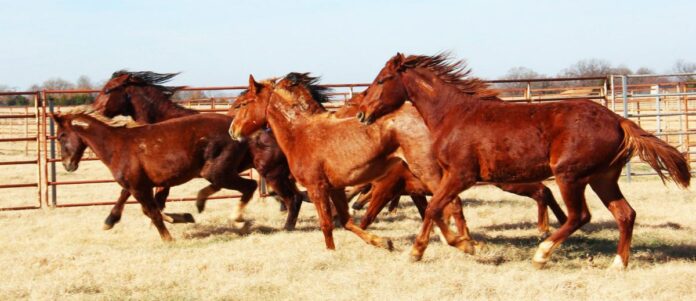MERCEDES — Cowboys and cowgirls can come adopt a wild horse or burro for one low price.
The Bureau of Land Management will hold a wild horse and burro adoption event at the Mercedes Livestock Show grounds on Friday and Saturday.
There will be 38 animals available for adoption on a first-come, first-served basis for the minimum adoption fee of $125 set by law.
A variety of mares, geldings, yearlings and burros from Arizona, Oregon, Nevada, Idaho and facilities in Oklahoma will be on display.
The mares and geldings are ages 2 to 5, and the burros range from 3 to 7 years old.
Wild horses range in height from 13 to 15 hands (averages approximately 13.3 hands) and burros 11 hands in height.
“It’s a great way for the community to get involved in the adopt-a-burro or wild horse program,” said Crystal Cowan, a BLM wild horse and burro specialist. “Theses animals make great companions and will do whatever the adopter wants them to do.”
Cowan said these are adult and yearling horses and burros that once roamed free on public lands in the West.
The BLM periodically removes excess animals from the range in order to maintain healthy herds, and to protect other rangeland resources. The adoption program is essential for achieving these important management goals.
Since 1973, the BLM has placed more than 235,000 of these “living legends” in approved homes across the country.
“We will approve applications on-site,” Cowan said. “To qualify to adopt, one must be at least 18, with no record of animal abuse. “
She said adopters must have a minimum of 400 square feet of corral space per animal, with free access to food, water, and shelter.
The BLM pays a one-time $500 care-and-feeding allowance to adopters of horses that are at least 4 years old. The BLM pays the allowance after one year when adopters receive official ownership title for their horse or horses.
All standard adoption conditions and fees apply. A limited number of eligible horses will be available. Younger horses, burros and trained animals are not eligible for this incentive.
Cowan said BLM designed this incentive to find homes for older horses that might otherwise be destined for long-term pastures, where they would live out the remainder of their natural lives at taxpayer expense.
The BLM manages more than 245 million acres of public land, the most of any federal agency. This land, known as the National System of Public Lands, is primarily located in 12 Western states, including Alaska.
The BLM’s mission is to manage and conserve the public lands for the use and enjoyment of present and future generations under our mandate of multiple-use and sustained yield. In Fiscal Year 2015, the BLM generated $4.1 billion in receipts from activities occurring on public lands.
“We have lots of good adopters from the Mercedes area and have been there for more than 10 years,” Cowan said.




